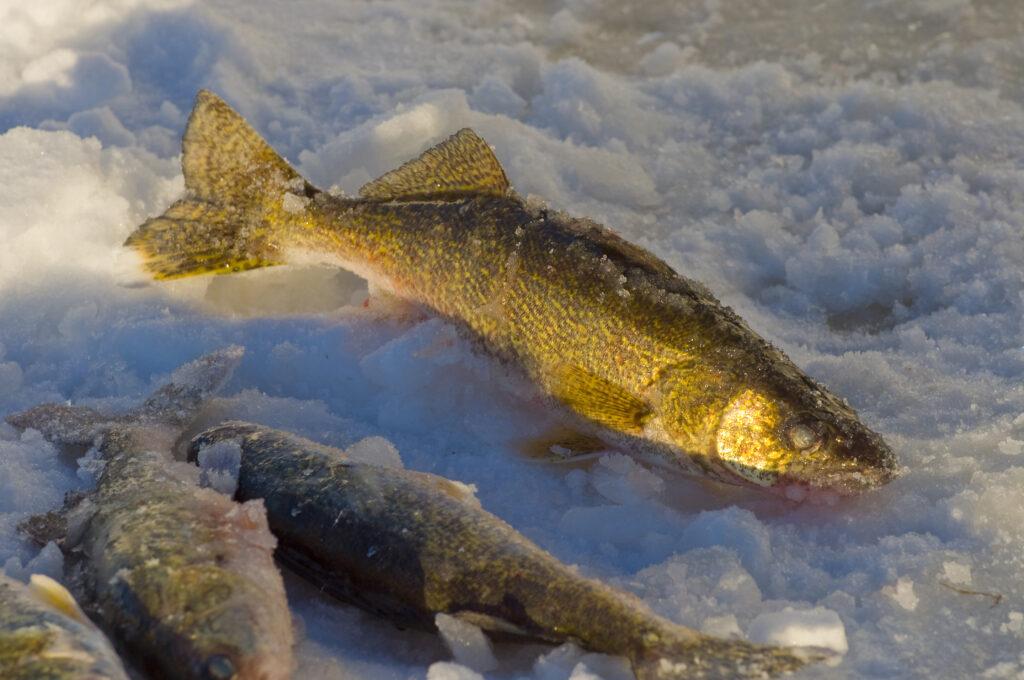For walleye ice fishing, lures come in all shapes and sizes. So, what size lure is best for catching walleye?
The best lures for catching walleye while ice fishing are small lures with slow, wobbling action such as jigging metal spoons.
In general, smaller lures are more effective for walleye. This is because walleye are relatively small fish and are less likely to be attracted to large lures. Additionally, small lures are less likely to spook walleye than large lures. When choosing a small lure, be sure to select one that is color that will be visible in the water.
When fishing for walleye, it is also important to use a lure that has a slow, wobbling action. This type of action is more likely to attract walleye than fast, jerky action.

The Best Lure for Ice Fishing Walleye
A few different types of lures can be effective for ice fishing for walleye. One common option is a jigging spoon, which can mimic a baitfish’s motion. Another popular choice is a minnow lure, which resembles a small fish. What Do Walleye Eat in Winter? is an article that outlines walleye feeding habits.
For both of these options, it is often helpful to use a bright color so that the lure is visible to the fish.
In addition, many anglers like to add a bit of scent to their lures to attract walleye. Salmon eggs and minnow oil are two popular choices. By experimenting with different lures, colors, and scents, you can find the combination that works best for you.
No products found.
No products found.
How Do You Use a Jigging Spoon For Ice Fishing Walleye?
A jigging spoon is a versatile tool that can be used for ice fishing walleye. The spoon is designed to imitate the movements of a wounded minnow, making it an effective way to attract predators.
To use the spoon, simply lower it down the hole in the ice and jiggle it up and down.
The spoon movement will create a flickering effect that will surely draw in the walleye. For best results, use a light-colored spoon and fish in areas with plenty of structure, such as sunken logs or rocks. With a little practice, you’ll be able to master the art of jigging and enjoy success on your next ice fishing trip.
What is the Best Way to Fish with Live Bait For Walleye?
When walleye fishing with live bait on ice, fisherman should use a bobber and bait. The bobber should be set about 18 inches above the bait so that the fish has to take in the entire bait in order to bite. The line should also be tight enough so that the fisherman feels it when the fish does bite.
Check out What Is The Best Bait For Ice Fishing? for more in-depth info on the best live bait for catching walleye and other ice fishing species.
The fisherman should reel in the fish quickly but not too hard to break the line. When using live bait, it is often helpful to use two poles so that if one pole gets a bite, the other pole can still be used to catch more fish. Check your local regulations to see limitations on how many lines you are allowed in the water.
When using live bait on ice, it is important to be patient and wait for a bite, as this method often results in more bites than other methods.
Soft Plastic Lure vs. Hard Body Lure When Ice Fishing for Walleyes?
Soft plastic and hard body lures can be effective while ice fishing for walleyes. However, anglers should consider a few key differences between these two types of lures. Soft plastic lures are often more versatile than hard body lures, as they can be rigged in various ways to target fish in different water depths.
Additionally, soft plastic lures tend to have a more natural presentation than hard body lures, which can be appealing to fish that are a finicky eater.
On the other hand, hard body lures often produce a more consistent action than soft plastic lures, making them a good choice for anglers who want to fish with a steady retrieve.
Ultimately, the type of lure you use when ice fishing for walleyes is up to personal preference and the specific conditions you’re fishing in. Experiment with both types of lures to see what works best for you.